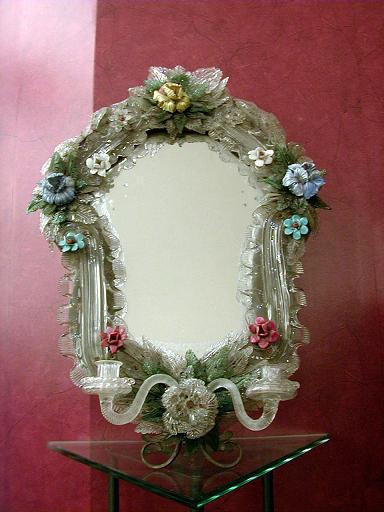Storia del vetro di Murano
Gli specchi venezianiVenetian glass mirrors

Venezia cominciò a produrre specchi di vetro alla fine del Quattrocento; le lastre venivano ricavate da grossi cilindri di vetro soffiato, aperti e spianati in apposito forno.
Raggiunsero il culmine della perfezione tecnica intorno alla metà del Cinquecento e il declino cominciò un secolo dopo, quando la Francia riuscì a carpire ai muranesi i segreti di fabbricazione.
A Murano la tecnica a soffio fu mantenuta anche dopo l'invenzione dei vetri colati, alla fine del Seicento in Francia, che permetteva di ottenere lastre di grandi dimensioni, ma meno brillanti e trasparenti.
Soltanto verso la metà dell'Ottocento vennero accolte le novità tecniche straniere, ma tutta l'arte vetraria muranese era ormai in decadenza, pronta però al risorgimento di qualche decennio dopo.
Glass mirrors began to be produced by the Venetian glass makers at the end of the 15th century. Glass sheets were made from large-sized blown glass
cylinders placed in an oven, where they were opened and flattened.
The manifacture of glass mirrors came near to perfection around the midsixteenth century. Its decline begun a century after, when French glass
makers extorted the production secrets from the Muranese masters.
The blowing process was used in Murano also after the invention of cast glass, at the end of the seventeenth century in France.
Large-sized glass sheets could be obtained by this method, but less bright and transparent.
The new foreign techniques were introduced only around the midnineteenth century, when all Muranese glass arts were decaying, yet ready
to flourish again a few decades later



Paolo Zecchin Via Cappuccina 13 Mestre Venezia
Venetian glass mirrors
Venezia cominciò a produrre specchi di vetro alla fine del Quattrocento; le lastre venivano ricavate da grossi cilindri di vetro soffiato, aperti e spianati in apposito forno.
Raggiunsero il culmine della perfezione tecnica intorno alla metà del Cinquecento e il declino cominciò un secolo dopo, quando la Francia riuscì a carpire ai muranesi i segreti di fabbricazione.
A Murano la tecnica a soffio fu mantenuta anche dopo l'invenzione dei vetri colati, alla fine del Seicento in Francia, che permetteva di ottenere lastre di grandi dimensioni, ma meno brillanti e trasparenti.
Soltanto verso la metà dell'Ottocento vennero accolte le novità tecniche straniere, ma tutta l'arte vetraria muranese era ormai in decadenza, pronta però al risorgimento di qualche decennio dopo.
Glass mirrors began to be produced by the Venetian glass makers at the end of the 15th century. Glass sheets were made from large-sized blown glass
cylinders placed in an oven, where they were opened and flattened.
The manifacture of glass mirrors came near to perfection around the midsixteenth century. Its decline begun a century after, when French glass
makers extorted the production secrets from the Muranese masters.
The blowing process was used in Murano also after the invention of cast glass, at the end of the seventeenth century in France.
Large-sized glass sheets could be obtained by this method, but less bright and transparent.
The new foreign techniques were introduced only around the midnineteenth century, when all Muranese glass arts were decaying, yet ready
to flourish again a few decades later
